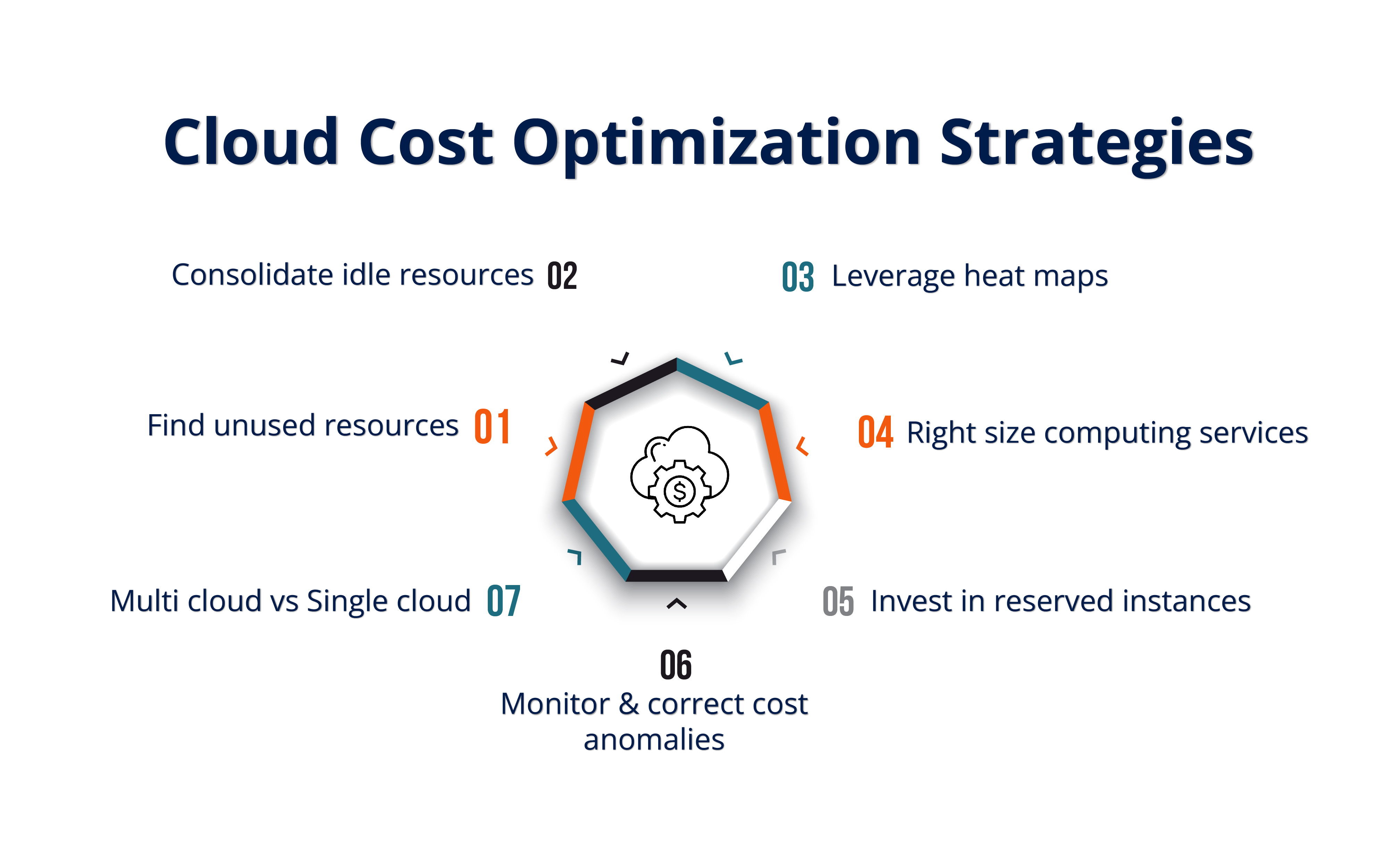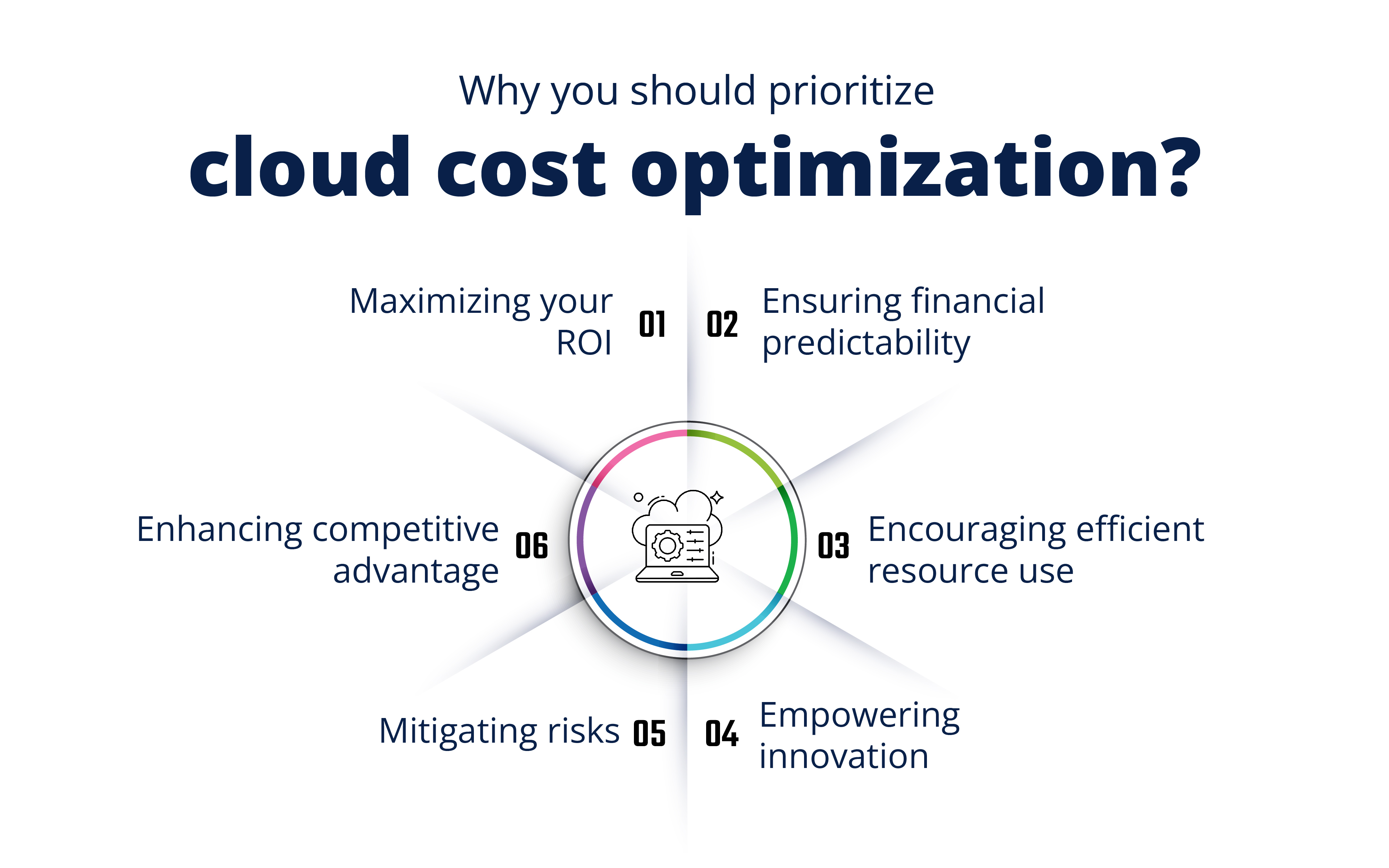Cloud hosting has become an essential element of modern digital transformation strategies, yet managing its costs effectively is critical to unlocking its full potential. In 2024, global cloud expenditure is projected to reach $482 billion, up from $410 billion in 2023, according to Gartner. Cloud cost optimization, which involves identifying mismanaged resources, eliminating waste, and reserving capacity for higher discounts, can yield potential savings of up to 30%, allowing businesses to reinvest in innovation and efficiency improvements.
Effective cloud cost management is vital for leveraging cloud hosting benefits without overspending. It requires continuous monitoring, right-sizing resources, and utilizing cost-effective pricing models, ensuring that organizations maximize their return on investment (ROI) and maintain a competitive edge. By implementing these strategies, companies can significantly reduce their cloud expenses, enhance performance, and improve reliability.
Current trends indicate a significant rise in multi-cloud and hybrid cloud deployments, driven by the need for flexibility and resilience. IDC reports that 90% of enterprises will adopt multi-cloud strategies by 2024. However, managing cloud costs remains challenging, with 57% of organizations citing it as a primary concern. Common issues include a lack of visibility into cloud usage, inefficient resource utilization, and unpredictable billing models. Addressing these challenges necessitates advanced tools, best practices, and a proactive approach to cloud cost management.

Tip 1: Understand Your Cloud Usage
Conducting regular audits is essential for optimizing cloud hosting expenses. Regular cloud audits help organizations understand their cloud services usage patterns, identify inefficiencies, and uncover opportunities for cost savings. Effective auditing methods include monitoring resource utilization, assessing security configurations, and evaluating cost management strategies. This comprehensive approach enables organizations to maintain an optimized cloud environment.
Identifying and eliminating waste is a critical part of cloud cost optimization. Unused and underutilized resources often contribute to significant unnecessary expenses. For instance, unattached volumes, idle compute instances, and underused reserved instances are common areas of waste in cloud computing. Organizations can detect these inefficiencies by leveraging auditing tools and techniques and take corrective actions, such as resizing instances, terminating unused resources, or consolidating workloads, to ensure optimal use of their cloud services.
Tip 2: Leverage Cost Management Tools
Cost management tools play a vital role in cloud hosting optimization by providing detailed insights into spending patterns and offering recommendations for cost reduction. These tools typically feature detailed cost breakdowns, forecasting, budgeting, and policy implementation to help manage expenses more effectively. They enable users to visualize spending trends, identify cost drivers, and implement policies to manage costs efficiently.
Implementing third-party cost management solutions can provide additional benefits. These tools offer advanced analytics, multi-cloud cost visibility, and comprehensive reporting capabilities, allowing organizations to gain deeper insights into their cloud spending across various cloud service providers in India. By integrating these solutions, businesses can achieve greater cost control, streamline budgeting processes, and enhance the overall financial management of their cloud hosting environments.
Tip 3: Optimize Resource Allocation
Right-sizing resources is a fundamental practice in cloud cost optimization. It involves adjusting the size of cloud instances to match the workload requirements precisely. This process starts with monitoring resource usage patterns and performance metrics, ensuring that resources are neither over-provisioned nor underutilized.
Implementing auto-scaling is another effective strategy to optimize resource allocation. Auto-scaling automatically adjusts the number of instances based on demand, ensuring that the right amount of resources is always available. This not only improves application performance and availability but also enhances cost efficiency by scaling down resources during periods of low demand. Auto-scaling features help organizations maintain optimal performance while minimizing costs.
Tip 4: Adopt a Multi-Cloud Strategy
Adopting a multi-cloud strategy offers significant advantages, including cost benefits and avoiding vendor lock-in. By distributing workloads across multiple cloud service providers in India, organizations can leverage the best features and pricing models of each provider, optimizing costs and enhancing resilience. Multi-cloud deployments also provide flexibility, enabling businesses to avoid being dependent on a single provider's ecosystem.
Effective management of multi-cloud environments requires robust strategies and tools. Comprehensive multi-cloud management solutions offer unified visibility, automated policies, and cost management features, ensuring that multi-cloud deployments are both efficient and cost-effective.

Tip 5: Optimize Storage Costs
Using tiered storage solutions is a strategic approach to optimize storage costs. Cloud providers offer various storage tiers, such as hot, cool, and archive, each designed for different access frequencies and performance needs. By categorizing data based on its access patterns and moving infrequently accessed data to lower-cost storage tiers, organizations can significantly reduce their storage expenses. This approach ensures that data is stored cost-efficiently according to its usage.
Implementing data lifecycle policies is essential for effective storage management. These policies automate the process of data retention and deletion, ensuring that data is stored cost-efficiently throughout its lifecycle. Automated lifecycle management tools help organizations enforce data governance, reduce manual efforts, and optimize storage costs by transitioning data to appropriate tiers and deleting obsolete data.
Tip 6: Take Advantage of Reserved Instances and Savings Plans
Understanding Reserved Instances (RIs) is crucial for optimizing cloud hosting costs. RIs offer significant cost benefits by providing lower rates in exchange for committing to a specific instance configuration for a longer term. Best practices for purchasing and managing RIs include analyzing usage patterns, selecting appropriate reservation terms, and continuously monitoring to ensure optimal utilization.
Savings plans provide flexible payment options that can further enhance cost savings. By committing to a certain level of usage over a period, organizations can benefit from reduced rates.
Tip 7: Manage Networking Costs
Optimizing data transfer and bandwidth usage is essential for controlling networking costs in cloud environments. Strategies to reduce data transfer costs include minimizing data movement, using efficient data transfer methods, and consolidating data transfer activities. Efficient bandwidth management techniques, such as optimizing network paths and using traffic management tools, can further reduce costs.
Utilizing content delivery networks (CDNs) can also provide cost savings by caching content closer to users, reducing data transfer costs and improving performance. Selecting the right CDN provider based on coverage, performance, and pricing is crucial for achieving optimal cost efficiency.
Tip 8: Implement Governance and Policies
Establishing a cost governance framework is crucial for effective cloud cost management. Governance involves setting policies and procedures to control and monitor cloud spending. Key components of an effective cost governance framework include defining roles and responsibilities, implementing cost control measures, and establishing regular cost reviews.
Setting budgets and alerts is an important aspect of cost governance. Tools for setting budgets and monitoring spending can help organizations stay within their budget limits and avoid unexpected cost overruns. Using alerts to notify stakeholders of spending anomalies or budget breaches ensures proactive cost management.
Tip 9: Educate and Empower Teams
Training teams on cost management best practices is essential for successful cloud cost optimization. Education helps team members understand the importance of cost management and equips them with the knowledge and skills needed to implement cost-saving measures effectively. Resources and training programs focused on cloud cost management can provide valuable insights and practical guidance.
Encouraging a culture of cost-awareness within the organization is equally important. Building a cost-conscious culture involves promoting cost-saving initiatives, recognizing and rewarding cost-saving efforts, and fostering a mindset of continuous improvement. This approach ensures that cost management becomes a shared responsibility across the organization.
Tip 10: Continuously Review and Improve
Regularly reviewing cloud spending is essential for maintaining optimized cloud hosting costs. Ongoing cost reviews help identify new cost-saving opportunities, detect inefficiencies, and ensure that cost management practices remain effective. Tools and processes for continuous improvement, such as regular audits and performance reviews, are critical for sustained cost optimization.
Staying updated with cloud provider offerings is also important for cost optimization. Cloud service providers frequently introduce new features, pricing models, and cost-saving options. By keeping track of these updates and leveraging new offerings, organizations can optimize their cloud services and achieve additional cost savings.
Final Thoughts
Effective cloud cost management is critical for organizations leveraging cloud hosting to drive their digital transformation strategies. By understanding cloud usage through regular audits and eliminating waste, companies can significantly reduce unnecessary expenditures. Utilizing cost management tools, both native and third-party, enhances visibility and control over cloud spending, ensuring resources are used efficiently.
Optimizing resource allocation through right-sizing and auto-scaling further ensures that cloud services align with workload demands, maintaining performance while minimizing costs. Adopting a multi-cloud strategy offers flexibility, resilience, and cost benefits by leveraging the strengths of various cloud service providers in India, while effective management tools ensure seamless operation across these environments.
Storage optimization, through tiered storage solutions and data lifecycle policies, ensures data is stored cost-effectively according to its access needs. Taking advantage of reserved instances and savings plans, supported by tools like a pricing calculator, helps organizations make informed decisions and maximize savings.
Networking costs can be controlled by optimizing data transfer and bandwidth usage and leveraging content delivery networks. Implementing governance and policies, setting budgets and alerts, and fostering a cost-conscious culture within the organization ensures that cost management is a shared responsibility and continuously improves.
Educating and empowering teams on cost management best practices, coupled with regular reviews and staying updated with the latest cloud provider offerings, ensures sustained cost optimization. By adopting these strategies, organizations can effectively manage their cloud computing expenses, drive efficiency, and achieve a competitive edge in the ever-evolving digital landscape.





















